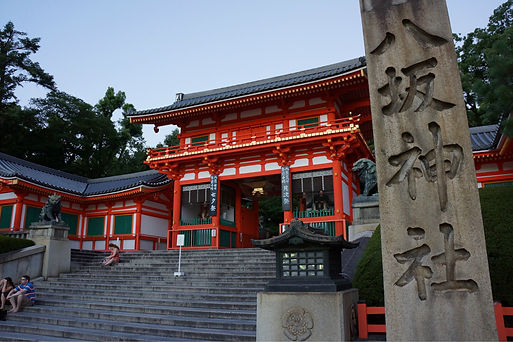Culture, Art and Traditions
Japanese Language

source: www.kitaq-koryu.jp/study
Japanese writting has three different characters : Hiragana, Katakana and Kanji. Those characters are derived from ancient Chinese writtings, Man'yōgana. While Hiragana and Katakana are used for syllables, the whole Kanji character conveys a deeper meaning.
The Kanamoji(kana character) is Hiragana and Katakana, this character is similar to English alphabet. It is possible to write a sentence using Kanamoji, however, it is difficult to understand. Generally, Japanese is a combination between the three characters.
Music and Arts
-
Gagaku
This music is performed in the Imperial Court in Kyoto more than 1000 years ago. It is a mix of song and dance in Japan, and music from the Asian continent.
-
Shōmyō
This is a music that puts melodies on Buddhist sutra and made it into a song. Shomyo music is brought from India, and reached Japan during the Nara Period.
-
Nō
This is a musical drama since the 14th century.
The story is often based on tales from traditional literature. The main character of the performance (shite) wears a mask that changes occasionally according to the role he plays.
-
Nagauta
This music is used for Kabuki theater around 1970s. Nagauta is sung with a lively voice, accompanied by the light tone of the shamisen.
Japanese Music has more than 1000 years of history. These are a few of kinds of traditional Japanese music :
Geisha Playing Shamisen (left) and Koto (right)

-
Shakuhachi
This is a music using an instrument called shakuhachi. This music is developed in the Edo period.
-
Sōkyoku
This is a music using koto, a musical instrument from China.
______________________________________________________________________________
Japanese art covers a wide range of art styles and media, including ancient pottery, sculpture, ink painting and calligraphy on silk and paper, ukiyo-e paintings and woodblock prints, kirigami, origami, and more recently manga—modern Japanese cartooning and comics—along with a myriad of other types of works of art. (wikipedia: Japanese Art)

The Great Wave off Kanagawa
source: www.en.wikipedia.org/wiki/The_Great_Wave_off_Kanagawa

Samurai Helmet Origami
source: www.tabizine.jp/2015/07/20/39946/
Religion
Shinto and Buddhism are the two major religion in Japan.
Shinto focuses on ritual that needs to be done diligently, to have a connection between the past, present, and future self. Japanese writtings does not refer Shinto as a religion, instead it is a spiritual way of life. Shinto touches every aspect of Japanese daily life: Moral principles, manners and customs, social structure, politics, arts, etc.
The word "Shinto" is derived from the kanji "shin" or "kami" means spirits or Gods, and "to" means philosophical path, in other words it means "the path of Gods". It's origin is the ancient faith animism, a religious belief that recognize the existence of the nature such as animals, plants, rivers, mountains, as well as gods and sacred essence. Kami and people are not separated; they are existing in the same world and are connected with each other.
It is said that Shinto had been found since the Jōmon era around 200BC. Then, Shinto originally appeared in the literature book "Nihon Shoki" in the 720AD.
Yasaka Shrine
___________
The Shrine is a place where Kami lives, and where people worship Kami.

Traditional Clothing
The Japanese word "kimono" literally means something one wears, they are the traditional clothing of Japan influenced by traditional Chinese clothing, Hanfu.
There are various colours of kimono. Mostly, men wears darker colours while women tends to have brighter, pastel colours and often with floral patterns.
Kimono is still worn today by women, men, and children. In general, kimono is commonly used in a formal event such as wedding, funeral ceremony, as a formal wearing. There are traditional celebrations that are appropriate for kimono, that includes New Year's Day, Shichi-go-san, Coming of the Age Day, and many other celebrations througout the seasons. Though it is also suitable to wear kimono in other situations such as shopping, graduation ceremony, alumni gatherings, theatre, tea ceremony, summer festivals, and much more.
Yutaka, is a casual version of kimono, it is worn during the summer season. Geta is a wooden sandal that is often worn with yutaka.


A women wearing kimono
source: www.japantimes.co.jp/culture/2015/07/18/books/underneath-orientalist-kimono/
A men wearing kimono
source: www.global.rakuten.com/en/store/kyoetsu-orosiya/item/otokomuji04/
Popular Culture
The Japanese pop culture start to make it's movement since the Heian era, it is highly influenced by foreign(especially western) entertainment, and the industrialization of the country. Some of the well-known Japanese pop culture: are: manga, anime, cosplays, and j-pop. If you are interested, you can find more about anime and manga in this site: www.japantimes.co.jp/news/2009/05/26/reference/manga-heart-of-pop-culture

Akihabara, the right place for electronics, anime, and manga
source: daringpenguin.com/2102
You might want to watch a 26-minute video about Japanese Culture by Dennis Wholey, who experiences the profound cultural depth of Japan.